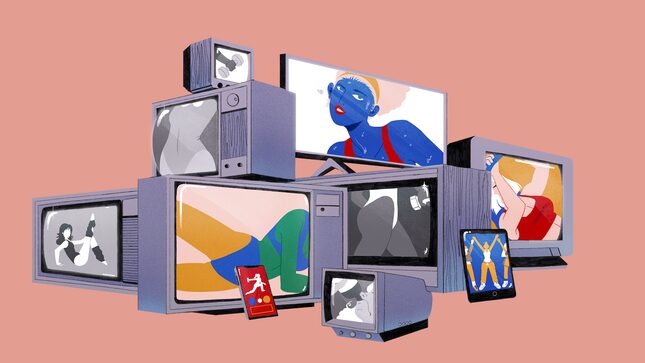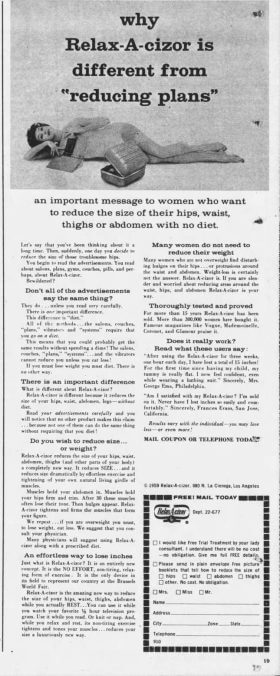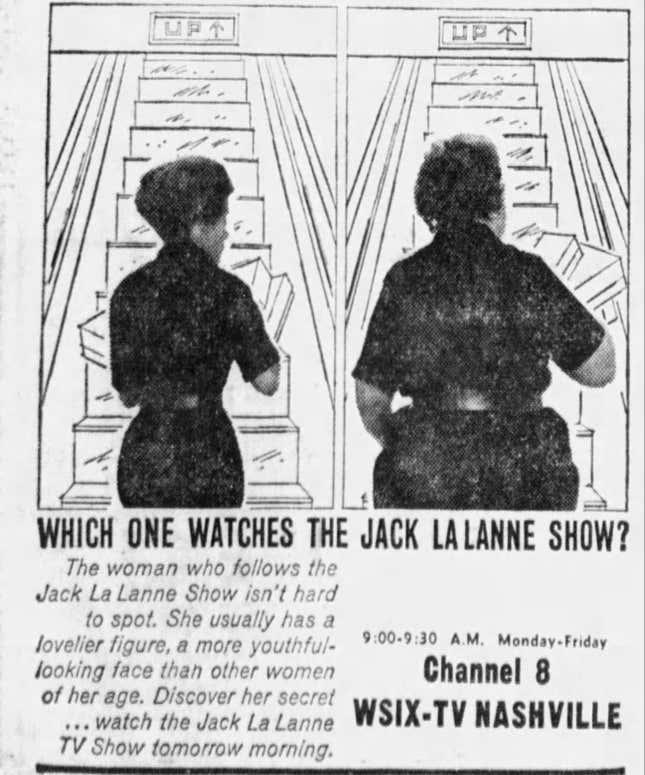Get in Shape Girl: A Century of Working Out from Home
In Depth
Illustration: Chelsea Beck
My husband emerged from the basement the other day, glowing and incredulous, and exclaimed: “Did you realize you can actually do a whole, legitimately good yoga class right at home?” A one-time college athlete, he used to hit the gym daily. But now, weeks into quarantine, he remains impressed by the endless permutations of downward dog and pigeon pose—not to mention classes from bootcamp to KidzBop cardio—available under our roof. Home exercise is a multi-billion dollar industry with roots a century old, but it’s not so surprising it took being housebound for him to “discover” it, or that my preferred platform, Obé Fitness, has a pastel-pink aesthetic: working out from home has for decades been marketed mostly to women assumed both to spend more time in the house and more energy on their appearance.
It wasn’t always that way. Men were aggressively marketed at-home fitness in the 1920s, when the whole idea of “purposive exercise” began to take hold. As the white-collar sector expanded, (overwhelmingly white) men engaged in “civilized” cerebral work learned they needed to deliberately exercise their bodies. Hours hunched over their desks, they feared, would make them weak, unattractive, and, eugenicists predicted, unable to procreate as fast as immigrants and minorities with hardier bodies and higher birth rates: effectively complicit in “race suicide.” But gyms were few and far between, and were generally considered sleazy gathering spots for men more interested in their appearance—or the company of other men—than appropriately masculine pursuits. Bodybuilder-cum-gym-entrepreneur Vic Tanny reflected that when he opened his first gym in the 1930s, getting men in the door was the biggest challenge. Men were doubly embarrassed: “to expose their potbelly and desire to get rid of that potbelly in a public gymnasium.”
Mail-order fitness was one solution. “Just a few minutes a day” and “no apparatus needed!” promised Charles Atlas, of the “Dynamic Tension” home exercise regime he began marketing in 1929. Atlas laid on the heteronormative masculinity thick, advertising in comic books with promises to beef up effeminate “97-pound weaklings” into real men who could attract beautiful women and beat up any male interlopers who tried to steal them. Any indication men sought aesthetic outcomes, like “banishing such ailments as…pimples, skin blotches, and the others that do you out of the good things and good times in life” was buried in the fine print, for such issues were embarrassingly womanly.

If men had to be aggressively convinced that they should exercise, fitness was far more socially acceptable for women, especially if it was in pursuit of beauty—an acceptable feminine aspiration—not a gateway to brutish sport. Cosmetics entrepreneurs like Helena Rubinstein and Elizabeth Arden built luxurious New York emporiums that offered “passive exercise” for “figure control” alongside skincare treatments. Countless products promised to replicate such miraculous results at home for women who didn’t have access to the high-end spas in New York. “You exert no effort,” declared a 1956 ad for the Relax-A-Cizor. Billed as “the normal, healthy way to pull in inches,” the device was for a “busy woman” who wanted “real exercise,” without the unseemly sweat of “bicycles, massage tables, heat, or massage.” On the contrary: “You use it while you read, rest, watch television… even while you sleep!” No surprise, the Federal Trade Commission register is chock-full of forgotten home fitness devices because so many, from reducing couches to bust-augmenting contraptions, sparked lawsuits.
But nothing established the normalcy of working out at home as much as TV. Between 1945 and 1959, home television ownership exploded from less than ten thousand sets to over 52 million, but exercise TV was no sure thing. When Jack Lalanne pitched studio executives a fitness program in 1950, they scoffed that no one would tune into a television show about exercise, much less set aside whatever they were doing to follow along in their living room. Undeterred, Lalanne launched his eponymous show out of his own pocket. Trimnastics—“I don’t like to call it exercise,” he would say. Millions of homemakers tuned in for his folksy fitness advice, completed with only a chair as equipment and offered as his dog Happy yapped around him. Lalanne soon received heaps of mail from viewers hungry for his expertise. “You know what happens when you have children,” lamented one mother about her spreading hips in a typical missive. In a tough-love tone that became typical over The Jack Lalanne Show’s 34-year run, he first cheerily assured her that “dumpiness” was in no way a foregone conclusion after 40. Yet he also issued a somber warning: only women’s own neglect of their bodies, or “using children as an excuse,” stood between the homemakers who made up his viewership and “the streamlined figure they want so badly.”
For a generation of women taught that exercise was unladylike and even dangerous, Lalanne’s thirty-minute, black-and-white show made the radical proposition of claiming that women should make time for exercise, for their own sake. Contrary to popular belief, he reassured viewers they would not ruin their figures with exercise. Metamorphosis, however, would not come from sitting on the sidelines at their children’s baseball game, or politely listening to their husbands’ war stories. “There’s only one time to start improving yourself and there’s only one time in your life and you know when it is?… NOW. N-O-W. This can make your life or break it,” Lalanne implored. He looked viewers in the eye and said, “You’re an intelligent person.” Biceps exposed, Lalanne boldly rejected ageism: “you know what age means? … Age means absolutely nothing.”

But Lalanne also made clear that looking pretty was inseparable from taking control of one’s life through exercise. “Which One Watches the Jack LaLanne Show?” a newspaper advertisement queried. If the side-by-side photos of women’s backsides identical but for their girth weren’t obvious enough, the copy explained: “the woman who follows the Jack LaLanne Show isn’t hard to spot. She usually has a lovelier figure, a more youthful looking face than other women her age.” He had little patience for those who wished for a new body, but failed to work to achieve it: “… you say ‘Dear God, give me the intestinal fortitude to do something about it.’ Then you get your new body. But you have to do it.” Exercise was becoming a required ritual of ladyhood, and thanks to Lalanne, home provided no solace from such reminders.
Ratcheting up the stakes of failing to exercise paved the way for more such TV. Debbie Drake, a Corpus Christi secretary plagued by “figure trouble” since a scrawny adolescence, launched a weekly television show in 1959. By fall 1960, “the most gorgeous calisthenics teacher in the country” was broadcast nationally on 74 stations, with a syndicated column and book on the way, The Shreveport Journal reported. “Debbie will take you through the wonderful world of exercise, to the land of slim, trim beauty,” assured a male announcer over the opening bars of the show. Drake, who favored leotards accented with a prim collar, an aesthetic equal parts propriety and Playboy Bunny, moved seamlessly from duck-walks to “build up the calves” to neck rolls for double chins, a problem about which “many girls” wrote in. One 1962 profile acknowledged that while most Cold War Americans understood physical fitness was a national security and public health issue, Drake’s motto was all about appearance: “To Make America the Beautiful—Exercise!”
Drake was just as direct as Lalanne in asserting exercise as imperative to women’s happiness—but not because it offered self-actualization or strength. By the 1960s, the idea that marriage and motherhood rendered a woman instantly unsexy was losing sway. Yet Drake helped establish an equally confining archetype: the “hot wife.” Rather than a reprieve from a long list of domestic duties, exercise, Drake explained, was required to guard against repulsing, embarrassing—or worst of all, losing—a man. Her exercise album How to Keep Your Husband Happy made clear fitness would help women allay their insecurities, but not by challenging the idea their self-worth was predicated on their desirability to men. Failing to fight cellulite could mean deservedly losing the affection of a man who now expected his wife to remain trim through exercise. This message struck a chord: the “matronly Mrs. who had rather be whistle-bait” was the target attendee for a live Drake beauty course at an Alabama theater.
“The masculine member of the household,” the ladies-only Alabama event announcement in the The Birmingham News snickered, “would have to do his Drake-watching at home.” And much to their wives’ dismay, men apparently watched Drake for reasons other than exercise. “The knowledge that men watch her syndicated program just to ogle,” another profile of the “dear girl,” written by a man for Kenosha News, “came as a complete surprise” to Drake. In a moment when TV married couples slept in separate beds and toilets were conspicuously absent from bathrooms, the unapologetic physicality of exercise television could understandably be titillating: in 1972, Cosmopolitan reported on a swinging Chattanooga couple who invited friends to their home to watch the television show Yoga for Health as foreplay, after which “the slide into group sex, southern style, came easily enough.”Television brought exercise home, but VHS made it on-demand. Inspired by the liberation she felt doing dance-aerobics, Jane Fonda opened her first brick-and-mortar fitness studio in 1979, and explicitly tied fitness to feminism. Her 1981 book framed exercise instructions with commentary on eating disorders, the environment, and workplace discrimination. But Fonda was at first skeptical of shooting a video, because so few Americans owned VCRs. But in April 1982, she released the Workout, sold 17 million copies, and effectively created a new genre. Unrestricted to American networks, Fonda’s tapes helped take fitness global; on a Soviet base in the Middle East, women gathered to do the videos during the Cold War, and in Colombia, “Beto” Perez skimmed her book before improvising a class that would become Zumba. Despite Fonda’s feminism, some women interpreted her videos and the others they inspired—from celebrities like Heather Locklear, Raquel Welch, and Cindy Crawford—as only creating more pressure to be thin, pretty, and now fit. One scholar, Margaret Morse, herself a passionate but conflicted consumer of aerobics videos, argued that the idealized mirror image of the viewer promoted unrealistic body standards and a “passive femininity.”
Morse was onto something. Southern California was the capital of both the fitness and pornography industries, and it doesn’t take a gender studies doctorate to pick up on some convergences in the genres. Muscle Motion: Featuring the Men of Chippendales is all winking double entendres and rippling muscles mashed up in a soft-porny montage of the popular male strippers doing aerobics for female viewers. (Personally, they favored weightlifting workouts.) “Caught with a madam or mistress again? Get ready to run…” is the female narrator’s sotto voce cue for the male exotic dancers, clad in tiny shorts, to do mountain climbers, butts high in the air; another characteristic line “Gotta keep Roger’s hands busy,” barely translates as an exercise instruction. Indeed, an Illinois physical education teacher who showed the 1983 exercise video in class soon found herself fighting for her job in a disciplinary hearing. For what it’s worth, its creators assured me Muscle Motion was also a great workout.
“Infomercials” made the pressure to exercise at home still more inescapable. Thanks to Reagan-era deregulation that lifted the limits on the length of television advertisements, off-peak hours were filled with “paid programming.” Giving the hard sell with enticements to “call toll-free now” for freebies and discounts, the form was perfect to sell home fitness. Captivated by commercials featuring before-and-after testimonials, clinical-sounding endorsements from doctors, and extensive product demonstrations, viewers vegging on the couch in the middle of the night were ideal targets for products that promised a healthier, more productive home life. Devices like Thighmaster and the Bowflex home gym benefited from infomercials, a medium that could make a business. Self-styled “Ms. Buns of Steel” Tamilee Webb told me she, and the brand, owe mass-market success to the early 1990s infomercial.
The eighties had established gyms as important sites of community, styled by Rolling Stone as “the new singles bars” in a story about Los Angeles’ swank Sports Connection, or as a “third space” during the HIV-AIDS crisis, as an owner of studio in the Chelsea neighborhood of New York City recalled. In part because of this popularity among the masses, the 1990s saw the birth of “the home gym” for those who could afford a more exclusive experience. “Fitness Centers Muscling into the Home,” read a typical headline announcing this architectural innovation allowing homeowners to “avoid the crowds and intimidation” of IRL gyms, and to literally build their disciplined commitment to fitness into domestic life. The shift was significant: one Santa Monica studio manager recalled shuttering the business as many affluent clients built home gyms.
Great Shape Barbie, the star of the children’s toy suite released in the 1980s and early 1990s, might best symbolize how normalized exercising at home had become over the 20th century. In addition to the Barbie, clad in the requisite leg warmers and belted unitard, Mattel soon released a Workout Center, a dance-aerobics video, and a Home Gym—for the doll. Barbies, and even more obviously the “Get in Shape Girl” toy, were meant for little girls. But the imperative to exercise at home increasingly knew no gender. In 1988, Nintendo released “Family Fun Fitness,” soon rebranded as the PowerPad, an electronic floor mat requiring players to trade the handheld controls for jumping around. It was a perfect pitch to parents who were heading to the gym in greater numbers than ever, and fearful that video games were creating a generation of sedentary, unfit kids. Plus, by offering athletic games, the PowerPad brought the archetypal sports-and-video-game-loving boy into the home exercise fold. My best childhood friend, whose parents bought her a PowerPad with a button that said, “I’m not fat, I’m just short for my weight,” confided her trick to win at its Track and Field game: pounding her feet extra fast from the couch while eating Baskin-Robbins from the container.
It’s easy to scoff at the ads of a century ago, promising in screaming bold print to MAKE A NEW MAN out of insecure weaklings who believed a mail-order booklet of isometric exercises held the secret to self-assurance. Or at the corny cues Lalanne used, like referring to abdominals as “the front porch,” that literally equated women’s bodies with the homes they kept. But these gendered histories are still very with us. Just think of that Peloton commercial: the outrage was in part because the ad went all-in on the old idea, rebranded in 21st-century talk of “transformation” and “journey,” that a wife would thrill at the gift of an exercise bike and its implied challenge—from her husband—to pile on strenuous workouts to an already busy life.
That said, the growth of home exercise has never been only about gender. For over a century before the much-debated Peloton and its offshoots grandly proclaimed to “democratize” fitness through digital technology, Americans have been enticed to exercise at home through products that appeal to our desire not only for personal transformation, but for perpetual productivity and privacy. The technology has evolved, but the same old questions are still with us: is working out at home a privilege or pressure? A reprieve from work or an extension of it? I’m writing a book about fitness culture, and my answers constantly change. One thing I know is that the best thing you can do when eyeballing the overwhelming array of home exercise options is to ask yourself if they feel more like self-care or suffering, and to choose accordingly. You can also just say screw it and take a nap, which sometimes is the best form of resistance training of all.
Natalia Mehlman Petrzela, PhD is Associate Professor of History at The New School and working on a book about fitness culture in the United States. She is also the host of a forthcoming podcast from Pineapple Street Studios.